#last universal common ancestor
Text




A love poem for the Last Universal Common Ancestor, the last of its kind and the first of our own at the beginning of the world.
#LUCA#Last Universal Common Ancestor#wikipedia poetry#wikipedia poem#poetry#she speks#she speks originale#she writes#my poetry
4K notes
·
View notes
Text
I just talked to a tree, it was great, it didn’t offer me any advice (it was a Sycamore) but it was comforting to feel surrounded by family in the woods since every living thing today has a shared common ancestor.
14 notes
·
View notes
Text
QUEM É LUCA?

LUCA do inglês (Last Universal Common Ancestor) — Último Ancestral Comum Universal, não é o primeiro ser vivo do nosso planeta, mas hipoteticamente um ancestral comum entre todos os terráqueos que evoluiram nesses aproximados 4,6/5 bilhões de anos terrestres.
A vida não evolui como uma escadinha, mas pense em LUCA como o primeiro da fila evolutiva de trás para

SE É UM ORGANISMO DO QUAL TODOS NÓS ORIGINAMOS, O QUE SERIA LUCA?
De fato não se trata de uma bactéria, e não pertence a algum grupo específico, porém é um tipo de organismo unicelular.
Não existe algum fóssel de LUCA, porém todos os seres vivos compartilham do mesmo código que traduz informações de DNA e RNA para a produção de aminoácidos, e consequentemente formarão proteínas, onde LUCA se apresenta em toda a cadeia de espécies.
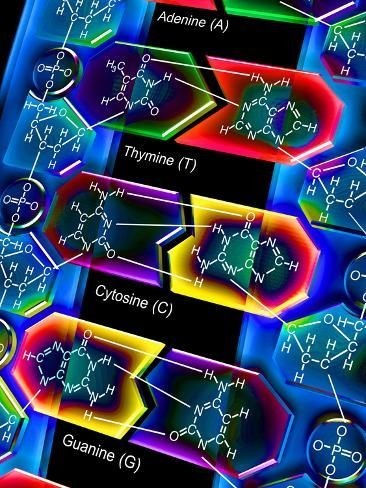
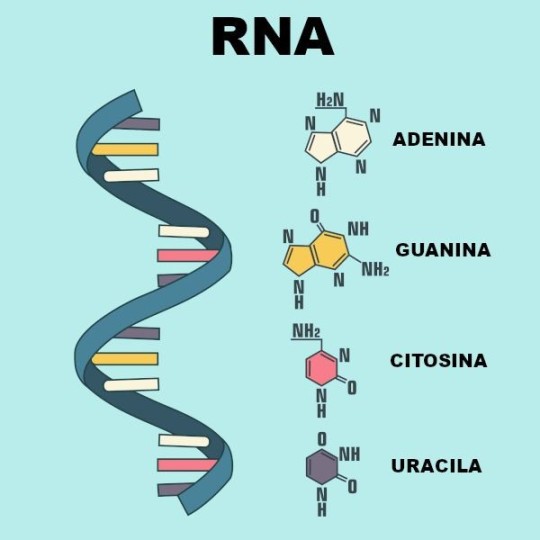
ONDE LUCA HABITARIA?
Há alguns anos cientistas acreditavam que LUCA teria se desenvolvido em lagos geotérmicos com temperaturas ultrapassando os 90°C, no entanto recentemente um grupo de pesquisadores (as) do Instituto Pasteur (França) encontraram evidências de que na verdade esse ancestral vivia em locais bastante gelados, pois não apresenta a proteína "girase reversa", resumindo — são extremófilos.

By: Celiny Arguilera
Referências bibliográficas:
https://www.bbc.com/portuguese/geral-47283064
https://g1.globo.com/ciencia-e-saude/noticia/2019/02/18/origem-da-vida-o-que-e-luca-o-antepassado-comum-dos-seres-vivos-que-habitam-a-terra.ghtml
https://www.nationalgeographicbrasil.com/assunto/series/one-strange-rock
https://pin.it/4EEfv5c
https://pin.it/6JvqZT3
#LUCA#Last Universal Common Ancestor#Última Ancestral Comum Universal#biologia#biology#Celiny Arguilera#ciência#science#brazil#brasil
11 notes
·
View notes
Text
LUCA may have been unrecognisable when compared to today's life – they may not even have been cellular in nature, but rather a collection of biochemical reactions involving proteins and self-replicating molecules, possibly contained inside rocky chambers around deep-sea hydrothermal vents.
"Human Universe" - Professor Brian Cox and Andrew Cohen
#book quote#human universe#brian cox#andrew cohen#nonfiction#luca#last universal common ancestor#biochemistry#proteins#rocky chamber#hydrothermal vents
3 notes
·
View notes
Text
REJECT HUMANITY
REVERT TO LUCA
4 notes
·
View notes
Text
Were NOT alone, never have been. We are just taught we are.......

Did ya know, we are finding that Life may have emerged not just once, but many times, and not just on Earth?
The more research we humans do, the more we realize we are far from being a miracle that happened just once over 4 billion years ago, and in fact life's beginnings could have been so commonplace in the universe that it began many times over throughout the universe,.......... this is the consensus we are leaning towards scientifically.
The more we know about the living earth and all of its life forms, the less we think we Human Beings are special. We are just 'one' of the universes many miracles of life.
Ya see, in 4.5 billion years of Earthly history, we think life as we know it arose just once. Every living thing on our planet shares the same chemistry, and can be traced back to “LUCA”, the "Last Universal Common Ancestor". So we assume that life must have been really hard to get going, only arising when an impossible set of circumstances combine. Like we think the Big Bang provided.
Sooooo some simple experiments by biologists aiming to recreate life’s earliest moments have challenged that assumption. And what they found is,... Life, it seems, is a matter of basic chemistry – no magic required, no rare ingredients, no bolt from the blue from some supreme being God is needed, Nope!
This tells us an even more intriguing possibility. Rather than springing into existence just once from some sort of God, it was rather in some chemically primordial pond, the universe, and life may have had many, many origins. It could have got going over and over again in many different forms for hundreds of thousands of years, becoming what we see today. And life as we know it might not be all alone out there in the vastness of space.
Just to be clear, what we are talking about came long before animals or plants or even microbes. We are going right back to the start, when the only thing fitting the description of “life”, was stardust. No bodies, organs or cells, reduced down to essential consciousness energy of stardust.
The more we know, the more we know we aren't the only ones,..... life that is!
Think about it.
0 notes
Text
boss makes a dollar i make a dime that's why i fall down wikipedia rabbit holes on company time
23 notes
·
View notes
Text
Seriously it’s like that domino meme lol one end is “me sitting down to watch my brother play some weird point and click game in 2012” and then the far end domino is a hundred pictures of the different mean, rude, and angry female characters I’ve been into ever since
#Lilly is truly the Last Universal Common Ancestor#without her there would be no Frey. there would be no Tannis. there would be no Emily Davis#and all the characters I got into as a result of Those characters#I likely would have continued down a dark path of saying female characters were badly written while being a fan of OG Kratos lmao
4 notes
·
View notes
Text
Making alliances in Hypixel walks a knife’s edge, and making friends is even worse.
spoiler alert i wrote more tma dsmp nonsense lmao. pre-dsmp hannah and tiredtwt for the soul
#dream smp#dream smp fic#tma#tma fic#luca#<- theres a name for the series now#(luca as in the last universal common ancestor :])#chrys writes
5 notes
·
View notes
Text
was gonna be like hey i drew a werewolf gunslinger for fun teehee then i realised that idea is just the captain from hellsing
0 notes
Text
yo mama so old her childhood best friend was the Last Universal Common Ancestor
4K notes
·
View notes
Text
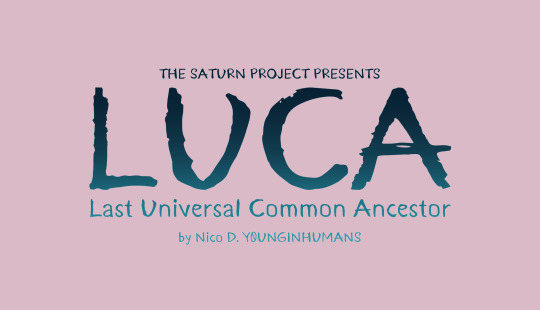
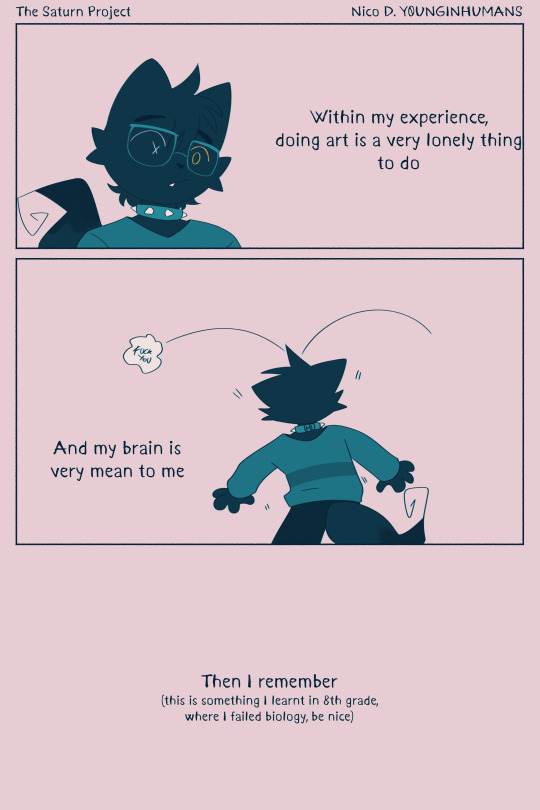
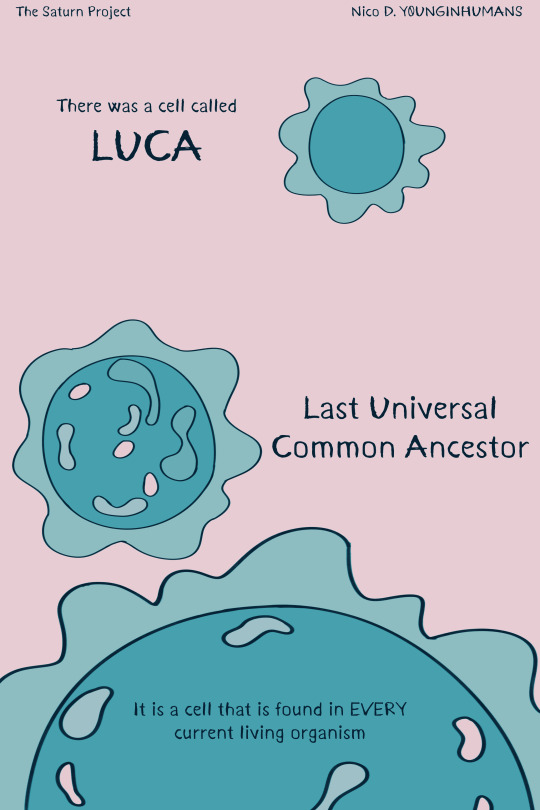

"Luca: Last Universal Common Ancestor"
A comic by me about loneliness and what has notoriously comforted me since 8th grade
I made this comic while feeling very alone and reviewing the things that have comforted me since I've learnt about them, LUCA is one of them, helpful probably for me and no one else.
COMMISSIONS | ART TUMBLR | MAINBLR
#furry#furry artist#sfw furry#furry oc#furry art#anthro art#anthro#on love#on loneliness#on life#webcomic#comic#comics#web comics#comic art#comic artist#my comic#webcomics#y0unginhumans art#clip studio ex
275 notes
·
View notes
Text
What Is and Isn't a Fish: an Essay and Guide by Fishyfishyfishtimes
A simplified list of the animals I discuss can be found here!
Hello folks! I created this post to have a kind of definitive essay/explanation of what is and isn't a "fish", starting with defining the term and going over animals that fit and don't fit the bill. As other fishblr artists, writers and educators must know too well, some people are confused about where this term begins and ends, mistaking other aquatic animals for fish. I have my fair share of arthropods and cnidarians as fish fact requests in my own askbox, heck, some years back a friend of mine asked me if clams were fish. The event that finally made me decide to write this was someone requesting that a fish-only account draw a crustacean, pondering to themselves if they count as fish.
I don't want to hold it against these people. It's impossible to know something when you've never been taught! So that's what I'm here to do, hopefully achieving a pretty correct and universal view ^^' If I make any mistakes please correct me. I'm learning all the same as everyone else is.
Definition of fish
Immediately, we run into a bit of a problem with the definition of fish. See, what the term "fish" means has fluctuated for centuries! For a long time, pretty much any animal that lived in water was a "fish" — I say "pretty much any" instead of "every" animal because for a long time sessile animals like sponges or corals were thought to be plants. This is why we have such remnants in our language like shellFISH, starFISH and jellyFISH, they lived in water so they were called such!
Occasionally these definitions would be changed for cultural convenience too. Many Christian churches take part in Lent, and in the Catholic church red and white meat is forbidden on Fridays and Ash Wednesday. In the Middle Ages, in my own country, Finland, this abstinence of red and white meat could last up to 140 days! To make fasting easier, many animals were labelled fish for convenience so they could be eaten as well. These newfound "fish" included seals, beavers and swans, pretty much just anything that was aquatic or semiaquatic in nature.
Nowadays just going off of looks or behaviour won't do, though. There has been much more of an effort to define fishes coherently based on their anatomy and phylogeny, which is great! Problem is, that's easier said than done: fishes are an extremely diverse group, and uh.. not really a single group, either. I'll show you:

As you can see from this heavily simplified phylogenic tree, fishes are not a singular group like, say, mammals are! The animals that we group under "fish" are actually a part of several distinct lineages of animals, some more closely related to us than each other. Heck, tetrapods, which include amphibians, reptiles*, and mammals, are fish themselves! Phylogenetically speaking. Our ancestors were lobe-finned fish, and, well, you never stop being the previous taxon even when you evolve into something else. If you try to exclude tetrapods, no such unified group as "fish" exists. Still, when discussing fish, we tend to want to avoid talking about every vertebrate ever and instead focus on the very specific aquatic ones we mean when we say "fish". This is why many definitions of the term "fish" still exclude tetrapods, even if we share a common fishy ancestor. "Fish" describes more of a lifeform than it does a clade, much like the term "worm"!
(*birds are reptiles! This could be a whole post in and of itself, but I'm not here to write about that. Someone else has most likely taken up the task!)
Hooray, it's definition time! As stated previously, fishes are an extremely diverse group of thousands of species, and what terms might apply to the Atlantic cod may not apply to the yellowfin tuna or giant mudskipper, let alone a Pacific lamprey! Encyclopedia.com defines a fish as "an ectothermic chordate that lives primarily in water and possesses a cranium*, gills that are useful virtually throughout life, and appendages (if present) in the form of fins". Encyclopedia Britannica notes that "the term fish is applied to a variety of vertebrates of several evolutionary lines", instead highlighting five classes. These five classes are left partly unspecified, but ones that are mentioned are jawless fish, cartilaginous fish and bony fish (which still includes tetrapods, however), and the two classes left can be assumed to be two classes of extinct fish. Wikipedia defines a fish as "an aquatic, craniate**, gill-bearing animal that lacks limbs with digits". Tim M. Berra, an academy professor and ichtyologist, defines fish as "poikilothermic***, aquatic chordate with appendages (when present) developed as fins, whose chief respiratory organs are gills and whose body is usually covered with scales".
(*cranium=upper part of the skull **craniate=an animal with a skull ***poikilothermic=an animal whose internal temperature varies considerably)
From these more or less detailed definitions we can gather many defining features for fish: a cranium-having chordate, primarily aquatic, gill-bearing and uses gills as their main respiratory organ, lacking any limbs with digits, instead having their limbs be in paired and unpaired fins when present. Most fish are also ectothermic, meaning their body temperature is determined by their environment, but some can heat up parts of their body or their entire body in the case of the opah. Most fish also have scales, but not all, just like how most fish are fully aquatic, but some like lungfish or mudskippers can spend considerable time out of the water. Such is the way of these magnificent and diverse animals!
Finally, with all this out of the way, we can get into...
What is a fish!
Here, I will be detailing animals that are fish! Well, at least the broadest strokes; there are more than 30 000 fish species and if I listed them all we'd be here all life. I shall instead go over the major classes and list, in short, some groups that belong in them.
Jawless fish (Superclass Cyclostomi)
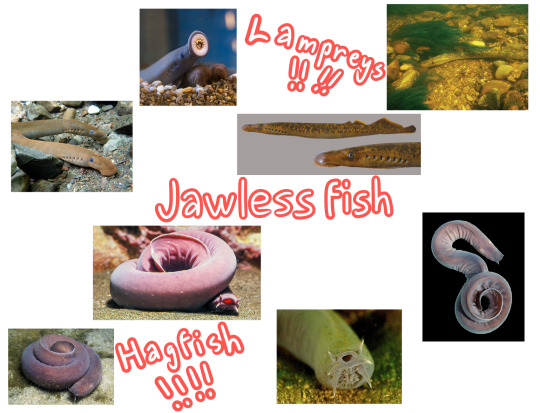
Jawless fish are often a topic of debate, especially in matters of their relation to each other and to jawed vertebrates. Evidence seems to point to hagfish and lampreys being closest related to one another and to lampreys being more closely related to jawed vertebrates than to hagfish (which would make hagfish craniates but not vertebrates). In the phylogeny tree above I decided to portray hagfish and lampreys as a monophyletic group, as molecular studies and microRNA analysis seems to point to a monophylegic superclass. Please note that this could go either way, though.
Jawless fish is a group containing two extant fishes, hagfish (class Myxini) and lampreys (order Petromyzontiformes)! Jawless fish are more "primitive" than other groups, for example both lack true vertebrae and scales. Still, they both have craniums and gills and they are aquatic, and so they have earned their place among fish!
Cartilaginous fish (class Chondrichthyes)
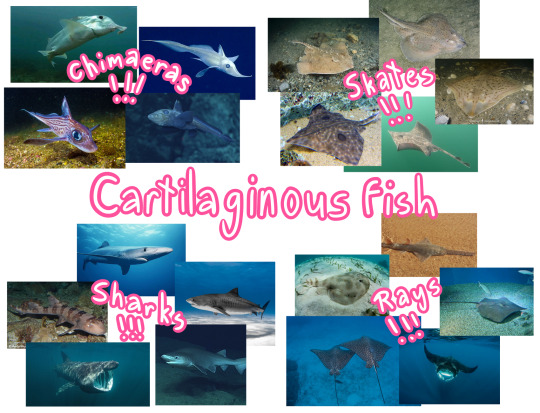
Surprisingly, I've found that this group has a lot of confusion surrounding it. I have received many a request confirming if sharks are fish, or asking if I'd cover a shark "even if it's not a fish". So I'll say it now: good news, sharks are indeed fish! So are their cousins, rays, skates and chimaeras, also known as ghost sharks! All of these fish have a primarily cartilaginous skeleton, tooth-like dermal denticles and lack gill covers and a swim bladder. Out of all the sharks, I also want to highlight that the whale shark, despite its confusing name, is a shark and not a whale. So, it is a fish!
Ray-finned fish (class Actinopterygii)
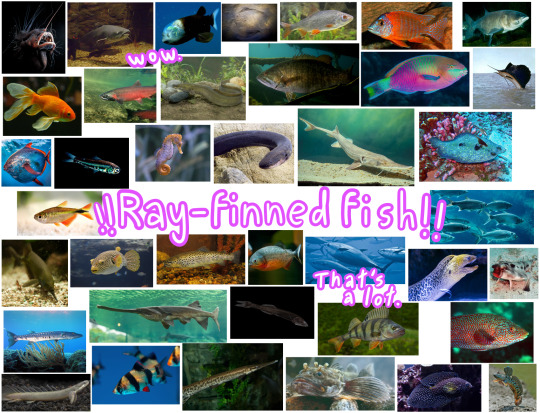
Name any fish, and there's a 96% chance the species name you said belongs to a ray-finned fish. Unless, like, you really like sharks. But this isn't about them.
Ray-finned fish are the biggest group of fish and incredibly diverse! It has your seahorse, your pufferfish, your bass, your tuna, your anglerfish, your clownfish, your salmon, your sturgeon, your lanternfish, your perch, your oarfish, your gar, your sardine, your moray eel... and this is only a tiny, tiny fraction of the groups that belong to this class! Defining features of ray-finned fish are that they tend to have a swim bladder and a bony skeleton (some exceptions though. Sturgeons, for one, have evolved a cartilaginous skeleton but they're still ray-finned fish). The largest group of ray-fins, the teleosts, also have leptoid scales, which are thinner and more flexible and grow with growth rings.
I want to bring special attention to some members of the ray-finned fish which tend to have a lot of confusion surrounding them and their heritage: eels and seahorses. Many people think these two are not fish due to their strange anatomy, like lack of scales or (many) fins and their elongated bodies, and I wouldn't blame them! Seahorses belong to family Syngnathidae, which also includes seadragons and pipefish. Eels, meanwhile, make up the order Anguilliformes. All of these long friends of ours are fish!
Lobe-finned fish (clade Sarcopterygii)

I shall merely focus on the fishy fishy fish individuals of this class, which excludes tetrapods. Lobe-finned fish house the two extant species of coelacanths, and six extant species of lungfish! These fish are bony and their fins are placed at the tips of fleshy, lobelike stalks, resembling the limbs of tetrapods. It is thought that the common ancestor of coelacanths and lungfish and tetrapods had similar structures that then became the four limbs the members of our clade typically have. Coelacanths and lungfish are wonderful fishes and deserve a lot of love and respect, not only because they're our closest cousins but because they're unique and we have so much to learn about them!
So, these are the fishes! There are also extinct groups of fish, namely class Placodermi (armoured fish) and class Acanthodii (spiny "sharks"). I'm moreso an extant fish account however, and so I shall move onto...
What isn't a fish?
Now we get into the real meat of this post. Without further ado, here are some aquatic friends of ours that can be mixed up with fish very often!
Crustaceans (subphylum Crustacea)
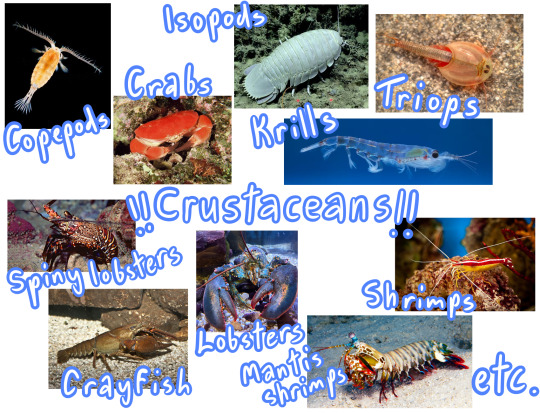
Many of our hard-shelled many-legged friends belong here! Crabs, lobsters, crayfish, shrimp, krill, isopods, triops, barnacles, copepods, you name it! Even though many crustaceans are aquatic or semiaquatic and have gills, you'll find that they're invertebrates that lack an internal skeleton (so no cranium, not even vertebrae)! We still love them though!
Mollusks (phylum Mollusca)

Creatures both soft and hard-shelled! Cephalopods like octopuses, squid, nautilus and cuttlefish, bivalves like clams, mussels, oysters or scallops, gastropods like sea slugs and snails and chitons go here! These friends of ours are also aquatic and have gills, some even have the suffix -fish (cephalopods used to be called inkfish, even!), but their lack of an endoskeleton is even more obvious than the crustaceans'. They're invertebrates, and therefore not fish!
Chelicerates (subphylum Chelicerata)
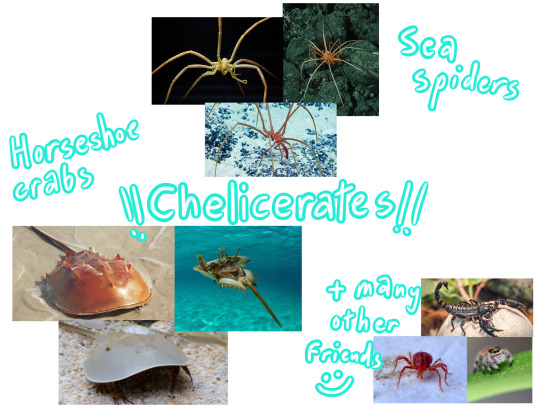
This group has many animals that are very hard to mistake for fish, namely spiders and scorpions, but horseshoe crabs and sea spiders are two groups of extant marine chelicerates! Both groups are aquatic, and horseshoe crabs have gills. However, they're both invertebrates, lacking a cranium or vertebrae. Other aquatic chelicerates exist, but they're usually very small, like water mites.
Cnidarians (phylum Cnidaria)

This phylum has the sessile corals and sea anemones and the usually more mobile jellyfish and siphonophores (includes the infamous Portugese man o' war!). I imagine corals and sea anemones are mistaken for fish less due to their sessile nature, but they're good to bring up nevertheless. None of these animals have a backbone, or, any bones really. They lack gills, they lack fins, they even lack the bilateral shape of fish. Jellyfish, despite the name, are indeed not fish! Some people suggest the name sea jellies be used for them instead, and I think it's much cuter.
Echinoderms (phylum Echinodermata)

Animals like starfish, sea urchins, brittle stars, sand dollars, sea cucumbers and feather stars go here. It seems that this pesky "-fish" -suffix is hard to shake off, as now we have the starfish. Once again, all of these slow-moving bottom-dwelling friends of ours are invertebrates, as they lack vertebrae or a cranium. Interestingly though, they are among our closest invertebrate relatives! So we ought to give them some props for that. I also want to mention that starfish can also be called sea stars, which ought to lessen confusion about their being too.
Comb jellies (phylum Ctenophora)

Comb jellies look a lot like jellyfish, but they belong in their own unique phylum! They have the same deal going on; they are invertebrates, they lack gills, they lack a cranium, they are simply aquatic.
Lancelets (subphylum Cephalocordata) and tunicates (subphylum Tunicata)
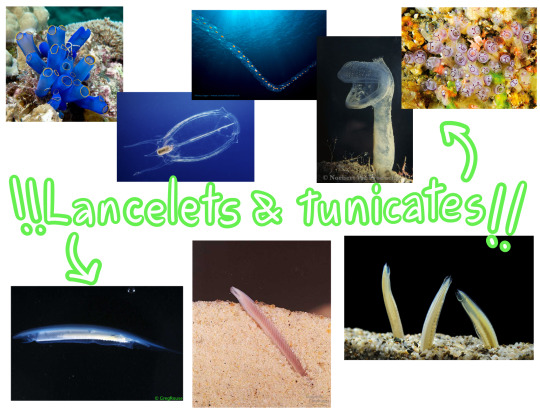
A double feature, because I wanted to save space didn't want these guys to be all alone! Lancelets and Tunicates, like sea squirts and salps, are chordates, which you can find in the phylogenic tree I drew all the way in the definitions section. They share many a feature with vertebrates, like a bilateral bodyplan, a notochord at some stage of life and a post-anal tail, but I'm afraid they're still not fish. They lack a cranium and their notochord does not develop into a vertebral column! Sorry friends, you tried. We can still hang out at the chordate convention.
Annelids (phylum Annelida)

The infamous bobbit worm, bone-eating worms, sea mice, giant tube worms, feather duster worms, spoon worms, bristleworms in general, leeches... many, many worms go here! Pretty self-explanatory: they are invertebrates, even when they live in water. They're extremely cool invertebrates too! I suggest taking a look at some of them, there's many interesting species.
Flatworms (phylum Platyhelminthes)

Flatworms are another very diverse group of worms, having many species both terrestrial and aquatic, however mostly I want to put attention into the free-swimming marine flatworms. They may swim beautifully (and fence with grace), but they are nevertheless invertebrates! Flatworms can live a variety of different lifestyles, from predators to parasites.
Amphibians (class Amphibia)

We've made it into vertebrates now! Amphibians include frogs, salamanders, and caecilians. While they have limbs with digits in their adulthood*, they can be easily confused for fish in their larval stages! This is no surprise, as they use gills to breathe underwater and tadpoles lack any limbs at all for a while. Many amphibians later transition into a terrestrial or semiaquatic way of life and lose their gills, not to mention gain their digit-having limbs.
(*excluding caecilians)
...Well, many amphibians do this, but not all. It's important to mention there are also species of aquatic salamanders which can bear great resemblance to fish with their elongated bodies! Amphiumas, which are sometimes mistakenly called "conger eels" (which is an actual species of fish), are aquatic salamanders with small residual limbs and both working gills and lungs. Giant salamanders and mudpuppies/waterdogs have lungs and gills as well, and lead an aquatic lifestyle — olms are close relatives of mudpuppies. Sirens, meanwhile, lack hind limbs and only have small front limbs, along with retaining their gills in adulthood. Among aquatic salamanders I also want to bring up one most often talked about species: the axolotl! They remain in their larval form, have external gills and lead an aquatic lifestyle. It can be hard to tell with aquatic salamanders sometimes, but these friends of ours are amphibians and not fish, even if they've rejected the land life.
Caecilians are a bit less known overall, but they can also cause a lot of confusion due to their long, limbless body. While most caecilians live underground, some are aquatic in nature, and can therefore be mistaken for fish! However, caecilians breathe via the use of their lungs and through the skin and don't have any gills at all.
Reptiles (class Reptilia)

Most commonly mistaken for fish in this group are sea snakes, sea kraits and water snakes, sea turtles, turtles, penguins, and other (semi)aquatic birds. Sea snakes and water snakes bear a very strong resemblance to eels, but they are indeed just snakes adapted to an aquatic or a semiaquatic lifestyle! The same goes for sea turtles, turtles overall, and penguins. They all need to breathe air and they lack fins, even if their flippers, webbed feet and built-in paddles may look like fins! They also have wholly different types of scales (or feathers!!) than what fish have, even if they share the feature. I assume that other aquatic reptiles, like the marine iguana and crocodilians are better read as reptiles thanks to their limbs with digits, but I want to give them a reptile shoutout anyway. They’re aquatic or semiaquatic, but they are air-breathers and fin-lackers all the same!
I also want to mention one specific extinct group of reptiles, ichtyosaurs! These marine reptiles were rather shark- or dolphin-like in appearance, which is actually a really good example of convergent evolution! Like all other reptiles, they also needed to breathe air and they had... erm... well, I'm not sure if I can call the bones in their flippers digits, but, that's what they used to be, so...? They were cool reptiles and among my favourites! There were many other aquatic reptiles too, but I will only mention just the ones now. A paleontology account would be better-suited to list you allll the marine reptiles.
Mammals (class Mammalia)

Our home class! Some of the aquatic friends we have in this class include whales like baleen and beaked whales, dolphins (orcas go here), porpoises, belugas, narwhals and sperm whales, pinnipeds like seals, sea lions, walruses, and sirenians like manatees, (occasionally known as sea cows) and dugongs! We also have some semiaquatic buddies like hippopotamids, otters, beavers and platypuses! Whales and pinnipeds especially often cause a lot of confusion due to their very streamlined, fishy appearance. They are, however, air breathers that feed their young with milk (some dolphin calves are even born with some hair), and their ancestors were land mammals! The same goes for pinnipeds and sirenians too. True seals, fur seals and sea lions still have fur even! Hippos, otters, beavers and platypuses are a bit more obvious as mammals with their fur and.. distinct air-breathing.. but I wanted to mention them anyway. Their adaptations to aquatic life are just one example of how fascinating evolution can be!
And here we are! A hopefully comprehensive list of fishes and non-fishes, beginning with the ever-shifting story of the term "fish", phylogeny, and why some animals are called fish when they really aren't. I hope you have found useful and interesting information in this post, and perhaps learned something new! I bid you a farewell! :D
#fish guide#fish essay#fish#fish facts#fishfact#marine biology#biology#zoology#long post#jawless fish#cartilaginous fish#ray-finned fish#lobe-finned fish
258 notes
·
View notes
Text
Romantic heterosexual relationships in humans may have evolved from same-sex pairings in a common ancestor of humans and chimpanzees, according to a novel hypothesis by a researcher at The University of Texas at Austin.
The prevailing explanation of heterosexual pair bonding and romantic love in humans is that it evolved from the mother-infant bond present in many mammals.
In a paper published in the journal Evolutionary Anthropology, anthropology professor Aaron Sandel cites primate research—including his own decade-long studies of chimpanzees in Kibale National Park, Uganda—to propose instead that this behavior evolved in humans from same-sex pair bonding already present in a common ancestor of humans and chimpanzees.
A pair bond is a cooperative relationship between nonrelated adults that remains stable over time and includes an emotional connection, rather than being merely transactional. Chimpanzees, humans' closest relative, do not pair bond with their mates, but adult males of the species form same-sex bonds lasting as long as 13 years.
Continue Reading
433 notes
·
View notes
Text
The Big Guide to Humans: Religion
Like many sapient species, humans have religion: beliefs in how their species first came to be, how they should behave, and what, if anything, to expect after death.
However, like languages, humans have thousands of these, some of which are very different from each other and some of which are nearly indistinguishable.
Broadly speaking, Terran religions can be divided 2 ways:
- Number of deities: Zero, one, or several. (Most Terran religions have insisted that their god/s are not just the correct ones to worship, but also the only gods that exist. This is shifting somewhat.)
- What happens at death: Nothingness, an eternal reward (or punishment) for the actions of one's soul (an animating essence of sapients), or the re-birth of the soul into another body (with difficult lives serving as punishments). Some combine these last two, with rebirth occurring until the soul is ready for its eternal reward.
"Zero deities" includes atheism, that is, believing only in what can be determined by science, with no belief in a soul. It also includes religions that don't focus on the creation of the world but rather on the purpose of one's actions.
"One deity" includes the most common and culturally powerful religions (this is including several minutely different sects of a few different religions). These have a single, all-powerful god that created the entire universe with humans as his master work. Since the discovery of life beyond Terra, sects have divided further over how to fit non-human sapients into their beliefs. Some sects actually insist their religious teachings do not allow for non-human sapients, at all, and we must be the disguised evil forces of their god's opponent. Luckily, and unsurprisingly, you will not encounter these sects' adherents outside of their home planet.
Because these religions have been so widespread for so long, many people who no longer follow the beliefs, or perhaps never did, may still set their calendar by the religious holidays and possibly hold celebrations anyway.
There are other, unrelated one-deity religions as well, though none remotely as widespread.
Religions featuring multiple gods have fewer practitioners (though some are still among the largest of Terran religions), but more variety. Some have powerful gods of large domains (e.g. of life or death, of oceans), some have very small gods or spirits of protecting single homes and occupying individual plant specimens, and everything in between. Some also worship deceased ancestors, either specifically by name or in a general sense.
Also common is for a human to have beliefs while not considering themselves a member of any particular codified religion.
Or, they may consider themselves a member, while holding beliefs that run directly counter to those of their professed religion.
For example: Some manner of belief in spirits or small gods seems common among humans*, even among those who would say they only believe in science or they believe in a single god of everything. While a person who acknowledges believing in multiple gods may make a ritualized offering to a river spirit to ask for safe water passage, for example, a person who insists they do not believe in spirits may still pour a heap of Fruity Pebbles (not fruit or rocks, a sort of breakfast candy, see diet) onto a malfunctioning machine to appease the spirit within.**
If a human's religion prevents or requires certain actions, they will tell you when it is relevant: that they need to wake up early for religious observances, that they can't join you for a meal because they are temporarily not-eating for religious reasons, etc. Some humans are very comfortable talking about their beliefs, others may consider them private. Some humans may be delighted to tell you about their religion because it encourages conversions; you are not required to convert if they ask you to and even other humans will find them rude to insist. Some humans may be curious about your beliefs, and some humans have even converted to religions of other species.
*These beliefs, mixed with human propensity toward empathy, are perhaps the source of "stabby the space roomba"-type incidents; see pets and human hive mind debate.
**This is an actual example experienced by one of our editors. The human was annoyed when the candy was removed and was further annoyed when asked why they were bothered if they did not believe the engine had a spirit.
#addie writes#big guide to humans#humans are space orcs#religion#Source for claim that some sects think aliens would be demons: 3 years of fundamentalist private school
124 notes
·
View notes
Text

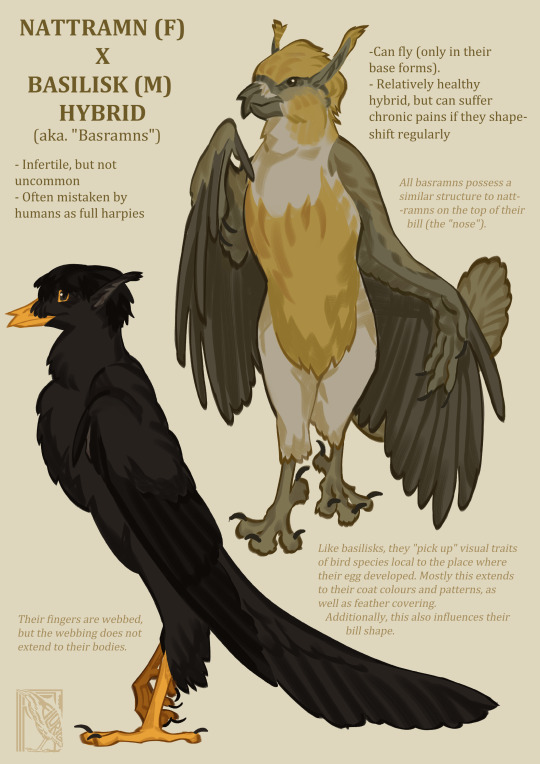
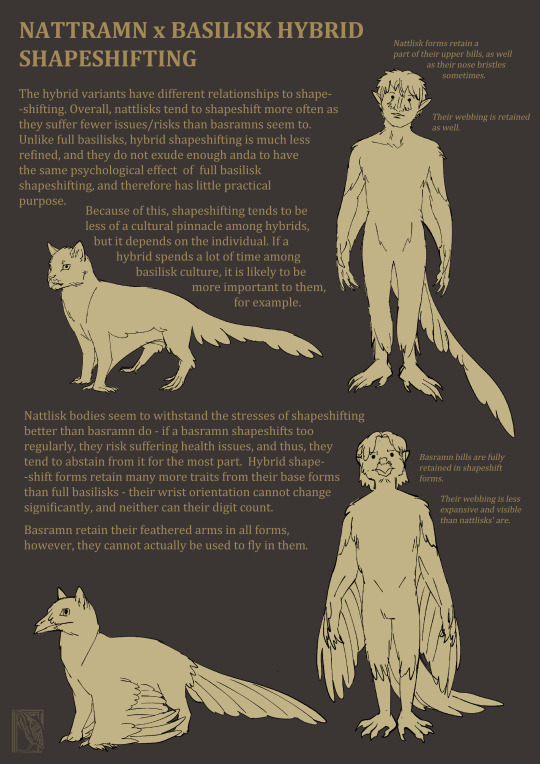

decided to go fawk it and make it so that nattramn and basilisks are able to hybridise in pareidolia yay!!! more info under cut
as for how its possible, irl clearly these species would be too distant from eachother to hybridise but ok its fantasy and also. i think part of it might be that as basilisk ancestors evolved their odd trait of picking up aspects of other fauna around them during fetal development, it just resulted in their genes being really wack and spontaneous and for some reason that made it so that they can procreate with nattramn again. i think the ancestors shown in the last image for example could not concieve together bcs the basilisk ancestor species had not evolved the wacky genes thing yet.
societally i think it varies on how they're treated. generally hybrids are accepted as parts of their societies, but depending on several factors they can be somewhat alienated. in nattramn society, "basramn" hybrids are generally more well accepted due to a combination of societal and religious reasons. "nattlisks" usually mingle with basilisk communities much easier for similar reasons. the kind of folklore that sprung up surrounding them in these communities may depend on the fact that basramns have an easier time fitting into nattramn society (due to nattramn putting a lot of importance on flight) while nattlisks have an easier time shapeshifting and can usually fit in basilisk communities easier because of it (basilisks celebrate their shapeshifting ability culturally quite strongly), and the folklore sprung up as sort of a "post hoc" justification for potential alienation/embracing of hybrids.
because of this this means that union between a basilisk and a nattramn and whether or not its accepted depends on the context bcs of what hybrid it produces. thinking this may be further reinforced with old legends about mythical (or real, potentially) historical figures in their cultures. (have to think more about this)
also i dont think ive mentioned it here but the reason why these hybrids arent TOO uncommon to see is that nattramn and basilisks are closely intertwined, and while its unusual to see a nattramn mingling with basilisk communities, its quite common for basilisk communities to exist within nattramn settlements and their attitudes towards one another are generally amicable/positive.
"nattlisk" and "basramn" are not canon terms for them, and in universe theyre generally referred to either as basilisk, nattramn or harpy depending on what the observer/local culture thinks they are lol. humans especially dont really know the difference - i think maybe nattlisks may be interpreted as some sort of other vätte like a rå or a troll due to their more humanoid look
generally have similar lifespans to nattramn/basilisks, overall they do rather well for being hybrids other than miscarriages (or, well, since theyre egg layers, failed/unhatched eggs) and nattlisks being more susceptible to illness early in life.
#pareidolia tag#bestiary#worldbuilding#lore#spec bio#speculative biology#spec evo#fantasy#harpy#creature lore#fantasy lore
125 notes
·
View notes